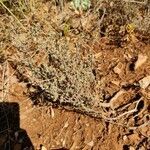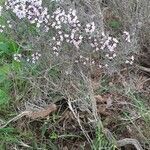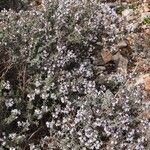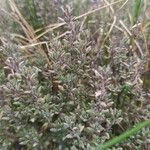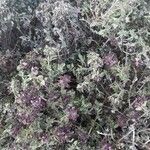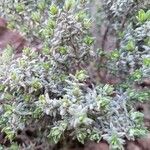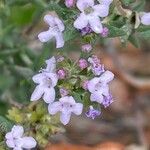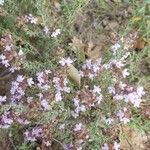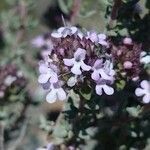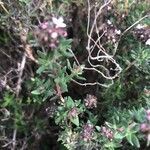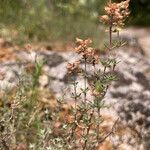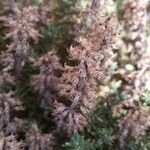Small, hairy shrub to c. 30 cm high. Shoots dense, erect or suberect, densely clothed in short hairs. Lvs sessile or subsessile, 3-8 × 0.5-3 mm, elliptic but appearing linear because of revolute margins, densely hairy, with abundant oil globules, tomentose along midrib below. Fls in dense terminal heads; lower verticels often interrupted. Bracts similar to lvs, often somewhat wider, green, < to > calyx. Calyx 3-4 mm long, campanulate, green or purplish, hairy, dotted with oil globules, with tuft of white hairs in throat; teeth of upper lip ovate, not ciliate; teeth of lower lip linear-subulate, long-ciliate. Corolla 4-6 mm long, white or mauve; tube not exserted, hairy outside; upper lip with large, broad, oblong-elliptic to obovate lobes, sparsely hairy or glabrous; lower lip at right angles to upper. Stamens not or scarcely exserted; anthers purplish. Nutlets 6-8 mm diam., broad-ellipsoid to sub-spherical, dark brown.
More
A low shrub. It grows to 20 cm tall and spreads to 30 cm across. It forms a bushy cushion. It keeps growing from year to year. It is an evergreen with woody grey roots. The branches are square in cross section and hairy. The leaves are very small and greenish grey. They do not have leaf stalks and are produced opposite one another. The leaves are 0.6-1.5 cm long. The edges of the leaves curl backwards and the underside of the leaves is very hairy. The flowers are pale mauve or purple. They form tubes with two lips. The flowers occur in rings towards the end of the branches. The plant has a sweet smell.
Corolla small, pale red or lilac.
A Mediterranean plant. It does best in dry arid places. Plants are occasional in the highlands in the tropics. They grow up to 2600 m altitude. It will grow on most soils and in most locations. It is resistant to drought and frost. They need sun. It suits plant hardiness zones 7-10. In Hobart Botanical gardens.
More
Dry slopes, rocks and maquis. Always found on clay or limestone soils.
The leaves and flowers are used as a seasoning to flavour foods. They are used fresh or dried. They are used to flavour stuffings, fish, meat, cheese, vinegar and gravy. They are added to the brine in which olives are pickled. It is used in soup that contains eggs and bread soaked in olive oil. The fresh or dried leaves can be used for tea. Young shoots are used as a garnish.
